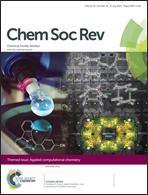The role of aromaticity in determining the molecular structure and reactivity of (endohedral metallo)fullerenes
Abstract
The encapsulation of metal clusters in endohedral metallofullerenes (EMFs) takes place in cages that in most cases are far from being the most stable isomer in the corresponding hollow fullerenes. There exist several possible explanations for the choice of the hosting cages in EMFs, although the final reasons are actually not totally well understood. Moreover, the reactivity and regioselectivity of (endohedral metallo)fullerenes have in the past decade been shown to be generally dependent on a number of factors, such as the size of the fullerene cage, the type of cluster that is being encapsulated, and the number of electrons that are transferred formally from the cluster to the fullerene cage. Different rationalizations of the observed trends had been proposed, based on bond lengths, pyramidalization angles, shape and energies of (un)occupied orbitals, deformation energies of the cages, or separation distances between the pentagon rings. Recently, in our group we proposed that the quest for the maximum aromaticity (maximum aromaticity criterion) determines the most suitable hosting carbon cage for a given metallic cluster (i.e. EMF stabilization), including those cases where the IPR rule is not fulfilled. Moreover, we suggested that local aromaticity plays a determining role in the reactivity of EMFs, which can be used as a criterion for understanding and predicting the regioselectivity of different reactions such as Diels–Alder cycloadditions or Bingel–Hirsch reactions. This review highlights different aspects of the aromaticity of fullerenes and EMFs, starting from how this can be measured and ending by how it can be used to rationalize and predict their molecular structure and reactivity.

- This article is part of the themed collection: Applied Computational Chemistry

 Please wait while we load your content...
Please wait while we load your content...